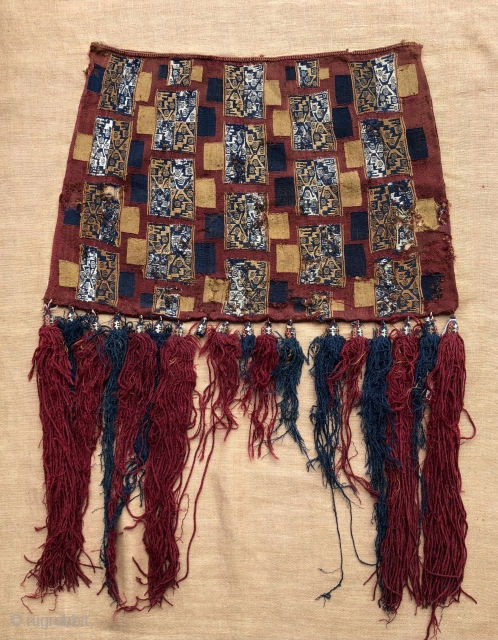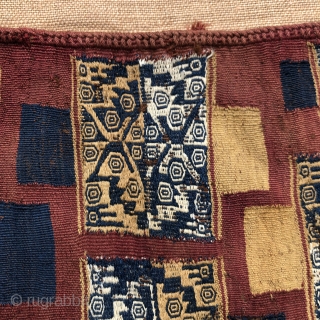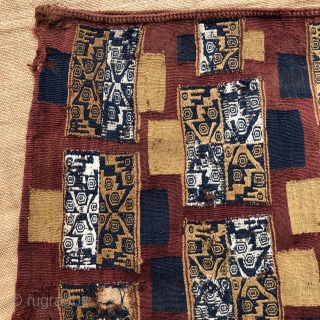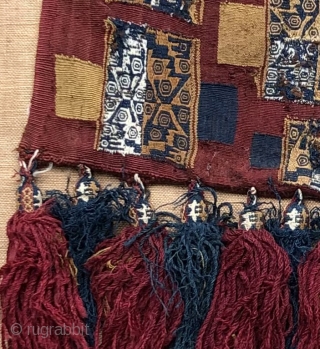Back
Very large Pre-Columbian bag for ceremonial use. Dating to the Late Horizon period - a.d. 1000 - a.d. 1500 It measures 24 x 31 inches. based on its impressive size and structure., this bag would have been the property of someone of high esteem within the community. Textiles of this type come from the Southern Andes in a region that is located in the far Southern area of what is today Peru and the far Northern border regions of Chile. i have owned this bag since about 1980 and it has been put away for many years. i recently re-discovered it in a storage container. It is basically complete and has been loosely sewn to a linen backing cloth, but it deserves professional conservation. It is clean and stable and can be displayed as is or easily mounted to a frame, but would definitely benefit with some careful conservation work. The design in the rectangles is very interesting. It contains allusions to bird-like creatures, profile faces with eyes as well as wing or tail feather imagery all done in a typical triple entendra sort of Andean fashion. The composite of the quartered design creates a stepped star or diamond-like design. The tassels show eight pointed star designs worked in a twining or braiding technique that encompass the long the bunches of red and blue strands of yarn of the tassels. The bag was purposely woven to be wider at the bottom. The whites are cotton fiber. All other areas are made with fine two ply alpaca yarns.
price:
SOLD - Thank you.
- Home
- Antique Rugs by Region
- Category
- Profiles
- Post Items Free
- Albums
- Benaki Museum of Islamic Art
- Budapest: Ottoman Carpets
- Gulbenkian Museum
- Islamic Carpets. Brooklyn
- Islamic Textiles. Brooklyn
- Konya Museum: Rugs
- MKG, Hamburg
- MMA: Caucasian Carpets
- MMA: Mamluk Carpets
- MMA: Mughal Indian Carpets
- MMA: Ottoman Carpets
- MMA: Safavid Persian Carpets
- MMA: Turkmen Rugs
- McCoy Jones Kilims
- Ottoman textiles. Met
- Philadelphia Museum
- Rugs and Carpets: Berlin
- Seljuqs at the Met
- TIEM, Istanbul: Carpets
- V&A: Classical Carpets
- Vakiflar Carpets: Istanbul
- Baluch Rugs: Indianapolis
- Gallery Exhibitions
- Jaf an Exhibition
- Alberto Levi Gallery
- Andean Textile
- Christie's London: 2016
- Francesca Galloway
- HALI at 40
- ICOC Washington, DC 2018
- Jajims of the Shahsavan
- London Islamic Week April, 2018
- Mongolian Felts
- Navajo Rugs: JB Moore
- Persian Piled Weavings
- SF Tribal & Textile Art Show 2020
- SF Tribal 2019
- Sotheby's: C. Alexander
- Turkish Prayer Rugs
- Turkmen Main Carpets ICOC 2007













